zur deutschen Version, Flagge klicken oder tippen

- Democratic People's Republic of Laos
- socialistic republic with one-party-system
- self-designation: Sathalanalat Paxathipatai Paxaxon Lao
• today's Flag
• historical Flags
– Champasak
– Luang Prabang
– Vientiane
• Meaning/Origin of the Flag
• Coat of Arms
• Meaning/Origin of the Coat of Arms
• Aircraft Roundel
• Map
• Numbers and Facts
• History
• Origin of the Country's Name
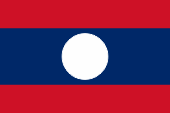
national flag,
ratio = 2:3,
Source:
Corel Draw 4






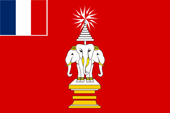
1893–1947,
national flag,
ratio = 2:3,
Source, by:
Wikipedia (D)



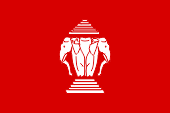
1947–1975,
national flag,
ratio = 2:3,
Source: Corel Draw 4





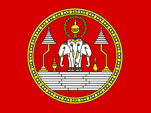
to 1975,
flag of the king,
ratio = 3:4,
Source, by:
Wikipedia (D)




The flag of Laos shows three horizontal stripes in red, blue and red, in ratio 1:2:1. In the middle of the blue stripe is situated a white disk. It was in use in the civil wars by the Patriotic Front (Pathet Lao) the armed sprig of the LPF-Party, and on the 2nd of December in 1975 officially introduced as national flag of Laos. Red stands for the in the struggle for the independence given blood, blue stands for welfare and bloom of the country, and white for the promise of a new and shiny future.
The flag of the French Protectorate of Laos was red with the French tricolour in the upper staff quadrant and with a threefold elephant on a pedestal, above that a sunshade and a star. It goes directly back to the flag of the Kingdom of Luang Prabang. The elephant's symbol in the middle of the flag symbolized the ancient name of the country: "Muong Lan Xan Hom Kaho" → "Country of the Millions of Elephants and the white Sunshade".
The Kingdom of Laos took over this flag on the 11th of May in 1974, but without the tricolour. As well the elephant's symbol was changed a little bit. This flag is still in use, namely from the opponents of the rule of the LPRP-Party.
Source:
Die Welt der Flaggen,
Flaggen Wappen Hymnen,
Flaggen und Wappen der Welt

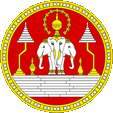
1947–1975,
coat of arms of the Kingdom of Laos,
Source, by: Wikipedia (EN),
commons.wikimedia.org
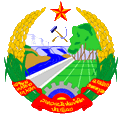
1975–1991,
coat of arms of Laos,
Source: Corel Draw 4
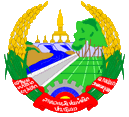
since 1991,
coat of arms of Laos,
Source, by: Corel Draw 4, Flaggen und Wappen der Welt

The coat of arms of the Kingdom of Laos was round and showed only the colours gold and silver. In the middle three elephants on stairs, above that a crown. To the left and on the right a sunshade. The coat of arms symbolized the ancient name of the country: "Muong Lan Xan Hom Kaho" => "Country of the Millions of Elephants and the white Sunshade". The coat of arms goes directly back to the Kingdom of Luang Prabang, whose king became king of the state of Laos in 1949.
The three elephants represent now the three kingdoms from which the land emerged: Luang Prabang, Vientiane and Champasak. The parasol stood for the monarchy and the steps of the stairs for the four most important Buddhist commandments: not to kill, not to steal, not do commit adultery and not to eat any intoxicants.
The coat of arms of the socialistic Laos (introduced on 2nd of December in 1975) showed between the years 1975 and 1991 a landscape with rice fields, a road, a building site, a forest as well as a waterpower dam. Above that hammer and sickle as soon as a sharpend red five-pointed star. All this was surrounded by a garland from rice ears, a red banner with the name of the country as well as a sprocket and the rising sun. The whole coat of arms was to interpret as expression of the socialistic developmental program of the country.
In context with the acceptance of a new constitution was the coat of arms changed a little bit in the year 1991. Hammer, sickle and red star became deleted. On its place appears now the pagoda of That Luang. It should symbolize tolerance of the state towards the buddhistic religion and the unity of the nation. That coat of arms shows very well that the communist LPRP-Party indeed had to make concessions, but is still on the power.
Source:
Die Welt der Flaggen,
Flaggen Wappen Hymnen,
Flaggen und Wappen der Welt,
Volker Preuß


1955–1975,
aircraft roundel,
Source, by: Wikipedia (EN)
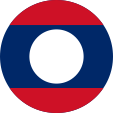
since 1975,
aircraft roundel,
Source, by: Wikipedia (EN)


Source: CIA World Factbook

Source: CIA World Factbook

Area: 91.429 square miles
Inhabitants: 7.038.000 (2017), thereof 78% Lao-Lum (Lowland Laotians), 17% Lao Theung (Highland Laotians), 5% Lao Song (Mountain's Laotians), and Chinese, Indians, Vietnamese
Density of Population: 77 inh./sq.mi.
Capital: Vientiane 350.000 inh. (2009)
official Language: Lao
other Languages: Tai, Lolo, Miao, Yao, Chinese, French
Currency: 1 Kip (K,LAK) = 100 At
Zeitzone: GMT + 7 h
Source:
Wikipedia (D),
Länder der Erde

13th cent. · the Thai nation of the Lao immigrates
1353 · Prince Fa Ngum establishes the Laotian Kingdom og Lan Tshang (Lane Xang)
1641 · the Hollander Gerrit van Wuysthof explores the country as first European
1707 · Lan Tshang disintegrates into the Kingdoms of Champasak, Luang Prabang and Vientiane
1778 · Siam (Thailand) conquers the Kingdom of Champasak
1779 · Siam (Thailand) conquers the Kingdom of Luang Prabang
1828 · Siam (Thailand) conquers the Kingdom of Vientiane
1893 · France purchases from Siam (Thailand) all territories eastern the Mekong River as well as Champasak and Luang Prabang, establishes the French protectorate and summarizes all the territories under the denomination Laos
1917 · Laos becomes subordinated the General Government of Indochina
1940 · Second World War, Japan occupys Laos, France retires, Japan centralizes the country
1941 · Siam (Thailand) occupies all Laotian territories western the Mekong River
15th of April 1945 · Japan dismisses Laos as a satellite state formally in independence
12th of October 1945 · proclamation of the independence by national forces
March 1946 · intervention of French troops, establishment of the French protectorate including the territories western the Mekong River
1947 · new constitution, Laos stays French protectorate
19th of July 1949 · Laos becomes independent as a kingdom in the framework of the French Community, what means granting of internal autonomy
1950 · communist Viet-Minh troops from Vietnam start invasion in Laos and occupy until 1954 perhaps the half of the country
21st of July 1954 · Genf Indochina Conference, Laos becomes independent, all foreign troops have to leave the country, the communist guerilla continues the struggle
22nd of March 1955 · foundation of the communist LPF-Party
1958 · open civil war under influence of the USA and the Soviet Union
1961 · Genf Laos Conference, agreement between the war camps
1962 · the communist LPF-Party and its armed sprig "Pathet Lao" begin the civil war again
1971 · the Second Vietnam War expands into Laos
1973 · armistice in Laos
May 1975 · the communist LPF-Party and its guerilla troop "Pathet Lao" seize the power
2nd of December 1975 · abolition of the monarchy, proclamation of the Democratic People's Republic, foundation of the state's party LPRP out of the LPF-Party
1984–1986 · frontier quarrels with Vietnam
14th of August 1991 · new constitution
Source:
Atlas zur Geschichte,
Wikipedia (D),
Discovery '97

The name "Laos" goes back to the Thai nation of the "Lao", which settles in this country in the 13th century.
Source: Handbuch der geographischen Namen


1713–1904,
flag of Champasak,
Source: SodacanThis W3C-unspecified vector image was created with Inkscape. [CC BY-SA 4.0], via Wikimedia Commons



The Kingdom of Champasak existed as an independent state between 1713 and 1778. After the conquest by Siam (1778), it belonged as a viceroyalty to Siam, but was little more than a province. Siam ceded the country to France in 1893. The monarchy did not end until 1946 by renunciation of the throne.
Source: Wikipedia (DE)

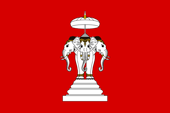
1707–1949,
flag of Luang Prabang,
Source: SodacanThis W3C-unspecified vector image was created with Inkscape. [CC BY-SA 4.0], via Wikimedia Commons



The Kingdom of Luang Prabang existed as an independent state between 1707 and 1779. After the conquest by Siam (1779), it belonged as a viceroyalty to Siam. Luang Prabang submits itself to under the protection of France in 1877. Siam ceded the country to France in 1893. The monarchy did not end until 1949, by renunciation of the throne, but the last king, Sisavang Vong, became king of the newly created kingdom of Laos in 1959.
Source: Wikipedia (DE)

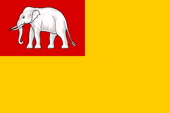
1707–1828,
flag of Vientiane,
Source: SodacanThis W3C-unspecified vector image was created with Inkscape. [CC BY-SA 4.0], via Wikimedia Commons



The Kingdom of Vientiane existed as an independent state between 1707 and 1828. After the conquest by Siam (1828), the kingdom was abolished. Siam ceded the area to France in 1893.
Source: Wikipedia (DE)


![]()























![]()



![]()



![]()
